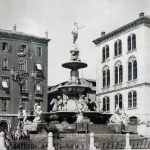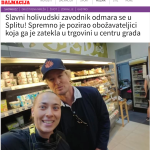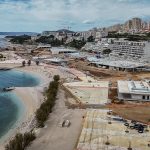August 30, 2019 – Mayor of Split, Andro Krstulović Opara, has appointed Marijan Čipčić, an employee of the City Museum, and professor of history and archeologist, as the coordinator for the restoration of the Monumental Fountain (Bajamonti Fountain) on the Riva. This is the first step in the long-standing debate over the reconstruction of the fountain, which was one of the most important city symbols in the late nineteenth and mid-twentieth centuries, reports Slobodna Dalmacija.
Recall, the Monumental Fountain was conceived by the then-mayor Antonio Bajamonti as the crown of the great event – the restoration of the water supply system from the Jadro, which still gives Split drinking water a thousand and a half years later.
It was commissioned in Milan in 1880, and water flowed from it ten years later, three months before Bajamonti’s death. It has also been considered a symbol of the community of citizens, since it was funded by residents of all classes, from bishops to the poor.
Its pools and allegorical figures symbolized the river Jadro and the Adriatic Sea, as well as mythological sea creatures, and the figure of a young man at the top of the fountain with his hand extended to the east referred to the economic orientation of Split towards the hinterland and Bosnia. Soon the fountain became an indispensable protagonist of city postcards, family photographs and monographs of Split.
It was demolished by an unknown decision of the Communist authorities on May 30, 1947, crushed with dynamite and used as a mound in road embankments, and several fragments were rescued by the Solin painter Vjekoslav Parać.
Thanks to the enthusiasm of Split’s older generation, a replica of the fountain was erected to film the Miljenko Smoje series ‘Velo Misto’, and whole families came to take pictures in front of the never forgotten stone beauty of Split. Unfortunately, more than thirty other public fountains and smaller fountains were erected on city streets and squares when restoring Diocletian’s aqueduct in the 19th century. However, only a few smaller ones survived, and two larger ones in Đardin and Pazar.
Since the 1980s, several initiatives have been made to restore the fountain, which the new Split named ‘Bajamontuša’. The first in 1990 was prompted by the restoration of the monument to Ban Jelačić in Zagreb’s main square.
At the beginning of the 2000s, new initiatives were created, more than 12,000 signatures were collected, and after months of deliberation by the Monuments and Streets Commission – since no original documentation was available to allow the fountain to be reconstructed – a compromise solution was made to build a fountain that would maximally respect the appearance of the original, which was accepted by the City Council.
The initiative for the restoration of the Monumental Fountain on the Riva in Split, formed in 2016, was the most vigorous in proving that the fountain could be replicated, several models were made, and documentation was collected, but no concrete steps were taken.
In March this year, Mayor Krstulović Opara did not announce how conditions were met for the fountain to be restored. In the Split budget for 2019, HRK 250 thousand is planned for the Monumental Fountain, while HRK 2.5 million is set aside for 2020, and HRK 5 million for 2021, which amounts to HRK 7.75 million or about one million euros over three years.
The named coordinator Čipčić said that his tasks were defined: proposing procedures for the implementation of the Monumental Fountain, monitoring the implementation of activities, proposing the dynamics of drafting technical documentation, preparing and monitoring information and educational activities, and reporting to the mayor on the dynamics of the project.
“The fact that the mayor has appointed a coordinator for the reconstruction project demonstrates that there is a strong will to finally and in the near future resolve the issue, to the delight of the many Split citizens whose ancestors co-financed its construction. Initiatives for its renovation date back to the late 1970s when a model was temporarily installed to film the series ‘Velo Misto’.
After the Commission for its Restoration was established at the Friends of Cultural Heritage Society in 2005, the restoration initiatives were intensified. I recall on this occasion the decisions of the City Council of 2006 and 2016, which decided that the Monumental Fountain would be restored, and Mayor Andro Krstulović Opara, following these qualities, included the funds for its reconstruction in the budget for this and next year,” says Čipčić, and reveals:
“The Conservation study is completed, which was sent for expert opinion to the Croatian Council for Cultural Property, the Ministry of Culture, and an advisory body for performing professional and other tasks in the field of protection and preservation of cultural property. My appointment followed this,” he adds, and points out that it is difficult to talk about deadlines the same day he was appointed to the position of coordinator.
“Everyone has their own opinion and that is quite legitimate. The vast majority of our fellow citizens are in favor of rebuilding the Monumental Fountain, as evidenced by various initiatives and signed petitions. But what is certainly important to emphasize here is that the decisions to renovate the Monumental Fountain were made legitimately within the institutions. Here again, I am reminded of the 2006 and 2016 City Council decisions.
That’s the merit of things. The renovation of the fountain on the waterfront in Split will re-enrich this space, as it ideally agrees with the close architectural forms of that part of Riva. The act of its restoration will correct one major historical injustice,” concludes Coordinator Čipčić.
You can read more about the fountain here.
Translated from Slobodna Dalmacija.
To read more about lifestyle in Croatia, follow TCN’s dedicated page.










